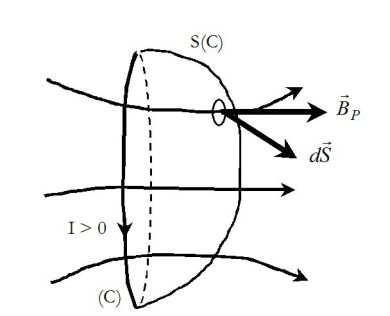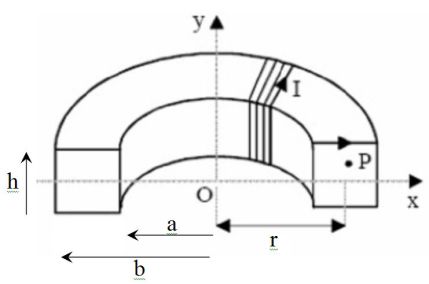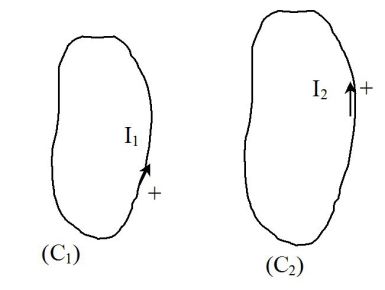Self-inductance, mutual inductance
Définition : Self-inductance
A closed wire loop
 is travelled by an intensity
is travelled by an intensity
 .
.
Its own magnetic field
 , which is given by Biot-Savart law , is proportional to
, which is given by Biot-Savart law , is proportional to
 .
.

The flux of the proper magnetic field through an outline which is oriented in the positive direction of the chosen current, is also called “own flux”.
It is proportional to
 :
:

The coefficient
 depends on the geometric characteristics of the circuit only.
depends on the geometric characteristics of the circuit only.
It is called the self-inductance of the circuit
 .
.
Sign of
 :
:
If
 , the magnetic field has the direction represented on the figure.
, the magnetic field has the direction represented on the figure.Its flux is positive so
 .
.
Si
 , direction of the magnetic field changes and the flux is negative.
, direction of the magnetic field changes and the flux is negative. Hence,
 is a positive coefficient.
is a positive coefficient.
The unit of the flux is Weber and the unit of the inductance is Henry.
Attention : Self-induction of a wire circuit

Exemple : Self-inductance of a solenoid
The magnetic field inside an infinite solenoid is :

The proper flux through
 wire loops occupying a given length
wire loops occupying a given length
 is : (
is : (
 )
)

Hence the self-inductance :

Order of magnitude :
For a coil of length
 , formed of
, formed of
 whorls and which has a diameter of
whorls and which has a diameter of
 , the self-inductance is around
, the self-inductance is around
 : Henry is a pretty big unit.
: Henry is a pretty big unit.
Bigger Self-inductances can be obtained by iron-core coils.
But the equation that gives
 is more complicated (
is more complicated (
 not only depends on the geometry of the circuit but also on the intensity).
not only depends on the geometry of the circuit but also on the intensity).
Exemple : Self-inductance of a torus coil of rectangular section
A torus coil has a rectangular section of height
 and radii
and radii
 and
and
 .
.
It contains
 joined whorls travelled by intensity
joined whorls travelled by intensity
 .
.
Any meridian plane is a plane of symmetry.
In any point of this plane, in cylindrical coordinates, the proper field is ortho-radial and depends on
 and
and
 :
:

The field lines are circles around
 axis.
axis.

Ampere's circuital law applied to a field line of radius
 :
:

The field actually does not depend on
 .
.
Its own field through the
 whorls is :
whorls is :

Hence the inductance :

Définition : Mutual Inductance

Two wire circuits
 and
and
 are travelled by intensities
are travelled by intensities
 and
and
 .
.
The flux of the magnetic field
 through the closed outline
through the closed outline
 oriented by the positive direction of current
oriented by the positive direction of current
 is proportional to
is proportional to
 :
:

Likewise, the flux of the magnetic field
 through the closed outline
through the closed outline
 oriented by the positive direction of
oriented by the positive direction of
 is proportional to
is proportional to
 :
:

 is the mutual inductance of these two circuits.
is the mutual inductance of these two circuits.
Unlike the inductance, which is always positive,
 can be positive or negative, depending on the orientation of the circuits.
can be positive or negative, depending on the orientation of the circuits.
Remark :
If
 can be calculated,
can be calculated,
 and
and
 can be deduced.
can be deduced.
Sometimes, one of the two fluxes is hard to calculate whereas the other one is easier.
